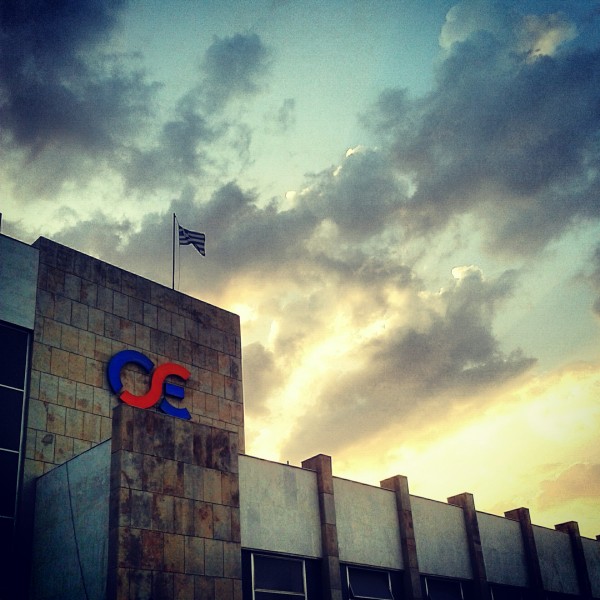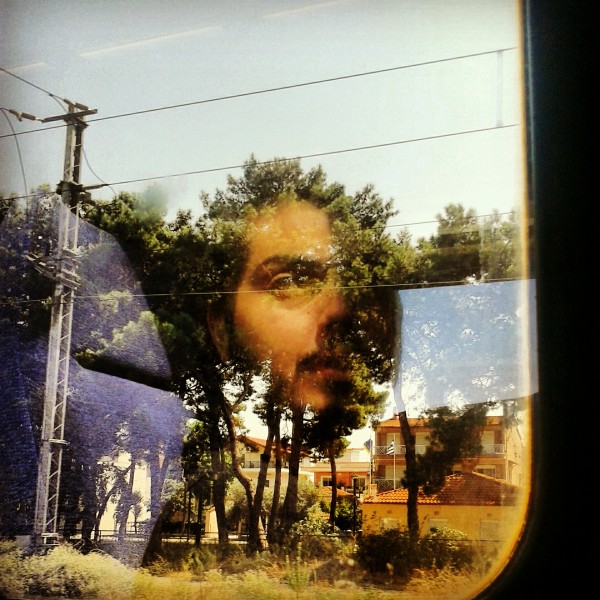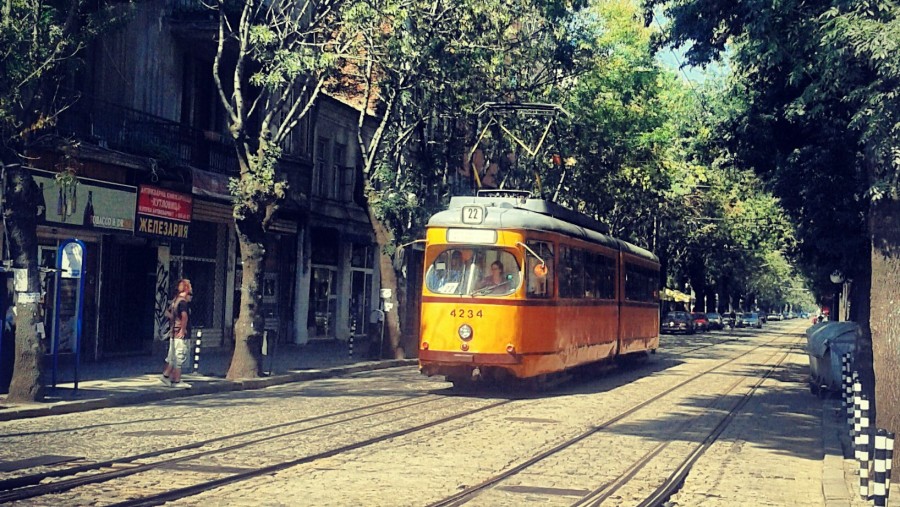
November 29, 2012: Matador Network, matadornetwork.com
Bulgaria: Sofia, Varna. Romania: Bucharest, Brasov. Serbia: Belgrade. Montenegro: Podgorica, Budva. FYROMacedonia: Skopje.
It was sometime around February when we first thought of doing something different this summer. Last year we had the best time in Tinos, the Holy Island of the Virgin Mary and Mykonos, the Party Island of Greece, but this year we wanted a real adventure. At first we discussed of going in Cairo, Egypt for a week, but that plan quickly aborted due to the latest riots in the country. UK also came in mind, Italy too and Spain (especially Barcelona). Neither of those countries however fulfilled our fantasies. “A trip by car would be nice” we thought, “a trip by train would be better” we decided. So, after a very helpful Google search my friend John and I found out that just like InterRail allows you to travel around Europe by train in a low cost, Balkan Flexipass allows you to travel around the Balkans, and the ticket is much cheaper. Greece, Bulgaria, Romania, Serbia, Montenegro, Former Yugoslavian Republic of Macedonia and Turkey.
We had only two weeks to travel around the Balkans, so we were in a bit of a hurry. And just because Turkey is quite a big country, unfortunately we had to leave it out. I took my passport in about a week, we had already bought our tickets (106 euro for 15 days in a month) and we were ready to go. The trip coincidentally began at the same time with the Opening Ceremony of the Olympic Games in London and completed at the same day with the Closing Ceremony. Although we missed the Games, it was like we were competing in a Marathon. We took the late night train from Athens to Thessaloniki and while Greece is not connected with any other country by train, we took the morning bus to Sofia, Bulgaria, our first destination.
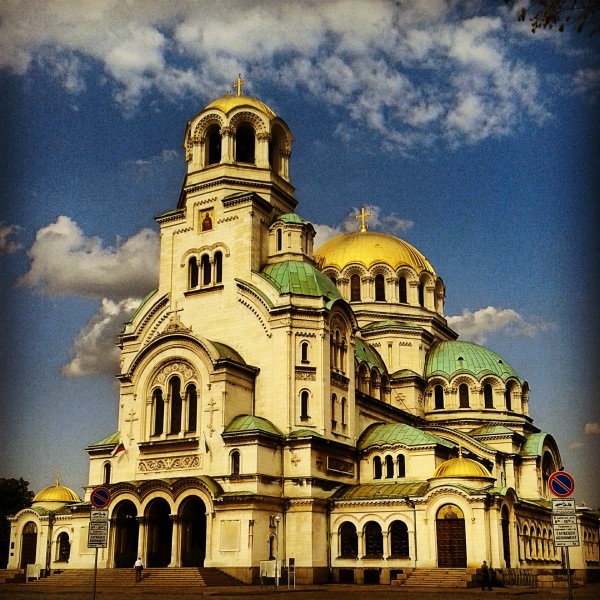
St. Alexander Nevsky Cathedral, Sofia (Bulgaria)
Before we leave home I have found on hostelworld.com the three best rated hostels in each city that we were supposed to stay for at least one night. As a result when we got off the bus in Sofia, we immediately start searching for the hostel we were staying. This wasn’t the first time we were visiting Sofia. We’ve been there once before, but only for a night. Now we were about to explore Bulgaria’s capital in the day light too. We found our hostel easily -with the help of a Brazilian new friend- and right after we went out for a walk. On the suburbs of Sofia we’ve seen a bunch of very tall buildings with more than a hundred apartments in each one, where the less wealthy families where living. But the center of the city was something else. The big Cathedral of Alexander Nevski is a monument of exceptional beauty and architecture. The golden and light blue domes combined with the countless windows all around the Cathedral are able to capture you in awe. The streets are large, but the tram crossing the biggest part of the city is very old. Although Bulgaria is a very cheap country (we had to change our Euro into Lev), we had to pay double ticket for our luggage in order to take the tram. We explored all the cities by foot, so I don’t know much of their underground metro system. Every one in our hostel was very friendly and they even gave us a map of the city with the “must see” spots. Near the Cathedral is a park, and in the morning there is a flea market where you can find souvenirs and antiques.
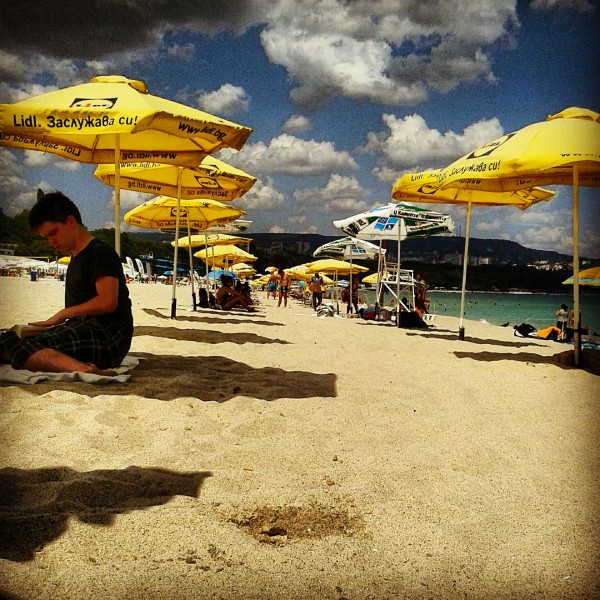
Beach in Varna (Bulgaria)
The next morning we took the train to Varna. Varna is the most touristic city of Bulgaria in the summertime. It is near the Black Sea, where you can swim, and it is on the eastern side of Bulgaria. Going from Sofia to Varna takes incredibly many hours inside a train, with no bar or any big stops on the way. So if you don’t have already bought a large bottle of water before you get in, you’re more or less… in trouble! Be careful! If anyone tries to help you at the train station, will probably later ask you for money, and there is no need for more expenses. In Varna we stayed two nights and met some really interesting people, whom I can now call friends, Jane from Taiwan and Fonsh from France. The day after, we went for swimming in a very sandy beach at the Black Sea, which was about 5-10 minutes on foot away from our hostel and the center of the city. There you can find all kinds of people, from families with two and three children, to topless women and elderly people all sunbathing under the hot sun. The train station from the center of the city is about 15-20 minutes on foot, if you like walking. The day before we leave for Bucharest, Romania, we found wondering around the city the flea market, where you could find cranberries in a cup with a plastic spoon, and that was our delicious breakfast for the day. They also have fresh almonds and walnuts.
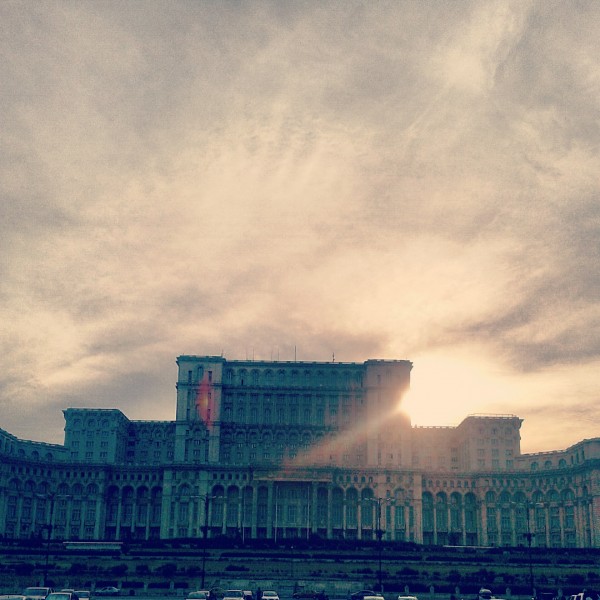
Palatul Parliamentului of Nicolae Ceauşescu, Bucharest (Romania)
To go from Varna to Bucharest, the capital of Romania, you must change train in Russe and then after three hours or more you’re there. The moment you are passing the boarders, over the Danube river, the wild nature around the bridge, is at least stunning. That day, the deeper we were going into Romania, the more the weather was changing. The sun was hidden behind dark clouds, the wind was blowing and the sunflowers, whole valleys of them, where dancing in the storm. Soon it started raining too. When having in the back of your mind the thought that Romania is the country of Count Dracula and the Vampires, even if you don’t believe in any of them, there was the appropriate atmosphere to make you believe. We arrived in Bucharest late at night and went straight to our hostel, which we have already booked at the same morning from Varna, thanks to our new friend Vesselina, who is working in the hostel there. In the meantime, all the exchange stores where closed and we had no Romanian Lei to buy anything to eat. However, that night we explored inch by inch -with commentary- the beautiful Bucharest with the help of Tim from Copenhagen and Natalia from Russia. With 2lt beer in a bottle and four cups in our hands, we had the best night of our trip. The morning after, we walked the streets in the day light and we even went shopping. This city, achieves to combine the old with the new, the Medieval with the modern. The colorful fountains in Piata Unirii and the gigantic Palatul Parliamentului of Nicolae Ceauşescu are the must see spots of the city, with the Old Town having the best bars and restaurants in the whole Bucharest. Romania has lots of dogs, so you must be careful because they usually hunt in herds and they usually are not very friendly.
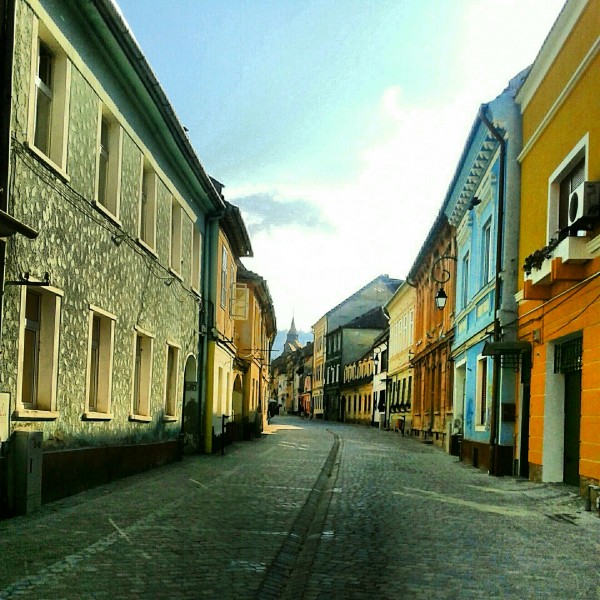
Brasov (Romania)
Two days later we took the morning train to Transylvania and Brasov, the city near the village Bran, where is the famous castle of Count Dracula. The truth is that the castle in Bran isn’t the real “home” of Dracula. The infamous Vlad Tepes, or Vlad the Impaler as he is more widely known, lived there for only 6 months and used that castle as a hermitage. But back in 1897, the best-selling Irish novelist Bram Stoker in his Gothic novel titled “Dracula” placed his character in the castle of Bran. From that day, the castle and the village around it became one of the biggest attractions of Romania. Brasov is a very beautiful town with medieval buildings. The Black Church of Brasov, which was burned in 1689 by the Turks, and the Hollywood-like sign with the name of the city on the top of the mountain, will definitely draw your attention. Our hostel was in a walking distance from the city center, but to go to the train station we had to take the bus.
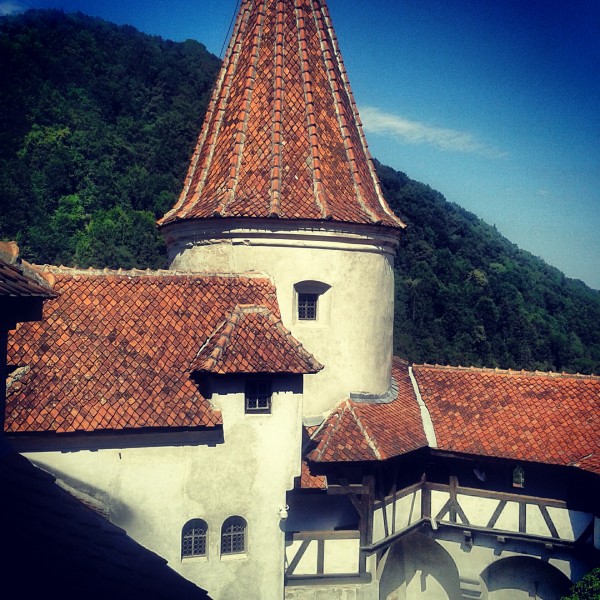
Count Dracula’s Castle in Bran (Romania)
The next morning we decided to visit Bran. It is about two hours away by bus. Around the castle there is a flea market with all kinds of souvenirs, most of them Dracula-themed. We bought our tickets and then walked quite a lot of stairs till the castle’s entrance. A big cross made of stone was right outside. The castle itself is very beautiful, and inside you can see some of the chambers where many great kings and queens of Romania lived. It is also decorated with some of the original memorabilia from the 1992 movie “Dracula” by Francis Ford Coppola. And after we’ve seen Dracula’s castle, it was time to leave Romania and go to Serbia, Belgrade.
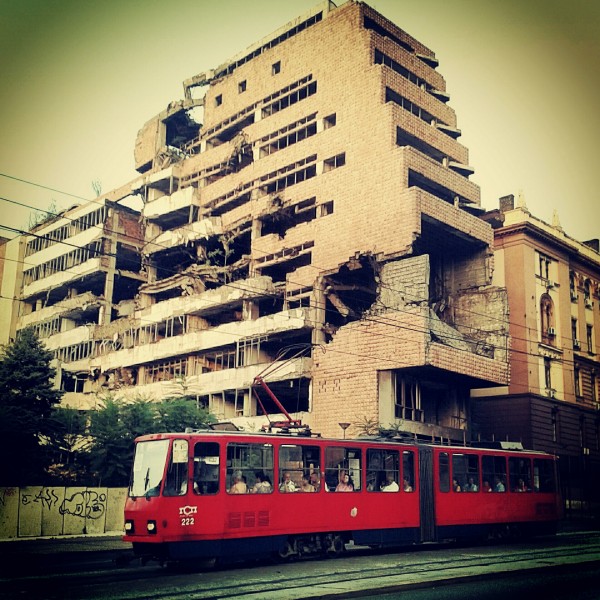
Bombed building in Belgrade (Serbia)
Going from Romania to Serbia was the toughest thing in the whole trip. It took us about two days to arrive in Belgrade. After we missed our morning train from Brasov to Timisoara, the city in the boarders of Romania, we had to go back in Bucharest to take the train from there. We travelled all night and arrived in Timisoara early in the morning. Then after about 10 hours we took another train to Vrsac, the city in the boarders of Serbia. After that we had to take a bus to finally get in Belgrade. In the meantime, we met a guy from Italy and a girl from Brazil, so we weren’t travelling alone. The first moments in the city, a taxi driver practically stole from us about five euro, trying to get us in our hostel which was about five minutes by foot from the train station. Anyway, the hostel we where staying was very beautiful. It was on the top floor of a very tall eastern European style building, with more than one hundred steps to climb. Belgrade is maybe the most beautiful city we’ve seen this summer. The Kalemegdan Park and the amazing view on the confluence of the river Sava and Danube is a jaw-dropping site-seeing. The fast food is so delicious and also very cheap. You can eat a whole day with less than five euro. Although the city was rebuild, some wounds made during the Yugoslav war in 1999 are still wide open. On the way to the Cathedral of Saint Sava, you pass through the ruins of giant buildings half collapsed but still standing there, just to remind you of the past. Next day we left for Podgorica, Montenegro.
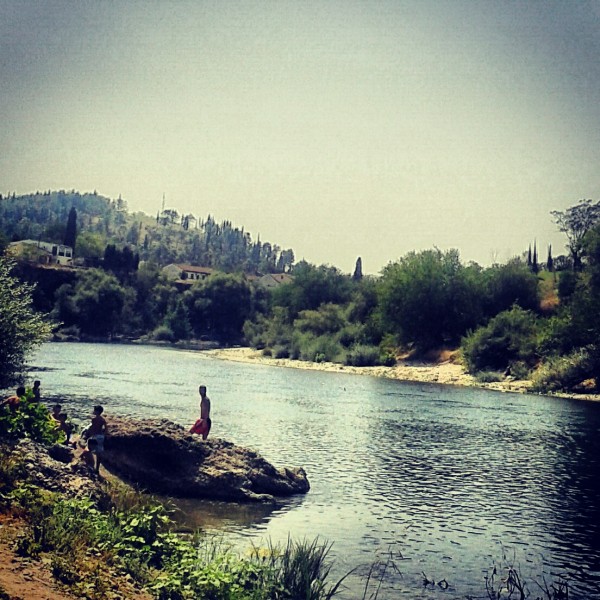
Morača river in Podgorica (Montenegro)
Podgorica, the capital of Montenegro, is surrounded by six rivers and that’s why it is the hottest city in the entire Europe. The Morača and Ribnica rivers flow through the city, while the Zeta, Cijevna, Sitnica and Mareza flow nearby. The climate is so hot and dry in the summer, that is able to catch your breath the moment you get off the train. Montenegro was the only country where we didn’t have to change in the local currency, as they use euro too. The Millennium Bridge and the Sahat Kula, an Ottoman clock tower, are the biggest landmarks of the city. On the banks of Morača river you can find cafe-bars and you can even swim in the river if you want, although the water is quite cold. What impressed me the most, is that everyone we saw walking around the streets was wearing always their swimsuit! Our hostel was near to the train station, however there was no train going to Budva, a coastal town of Montenegro and the most touristic, so we took the bus, which costs six euro each.
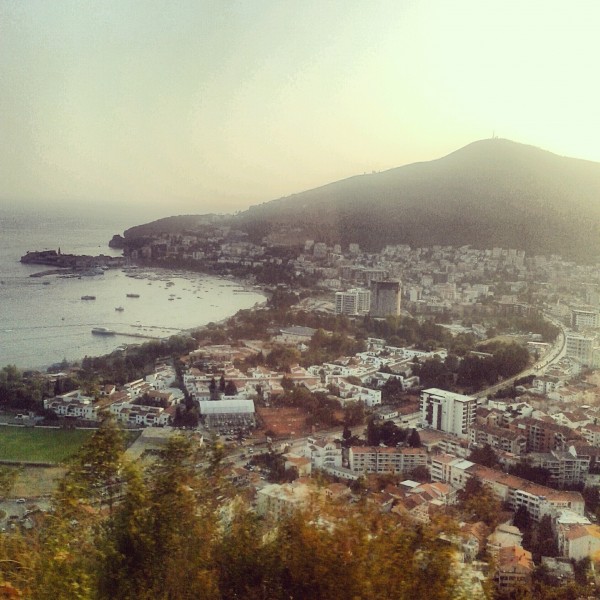
Budva (Montenegro)
The coastal area around Budva, called the Budvanska rivijera, is the center of Montenegro’s tourism, where every summer, millions of people come from all over the world for the sandy beaches and the intense nightlife. Our hostel was a bit crappy, but it was the only one that wasn’t full at the time. Budva has nothing to envy from any other cosmopolitan cities of Europe. In the morning the beach in the Adriatic sea is full with people of all ages and you have the opportunity to do water sports, such as jet-ski, wind surfing and more. When the night comes, the promenade is lightened up by restaurants, souvenir shops and at a certain spot there are big night clubs where you can have a drink and party till the morning light. One of the most certain places you should visit is the Old Town. Hidden behind big walls the Venetian design architecture of the Town with alleys, balconies and traditional churches is more than fascinating. Just like Belgrade and Podgorica the food in Budva is very tasty and cheap. Although meat is the most common food in these countries, in Budva you can find good restaurants with fresh seafood cooked in many different ways. I ate pasta with shrimps and it was just delicious. After two nights in Budva, we were ready to leave for Skopje, FYROMacedonia.
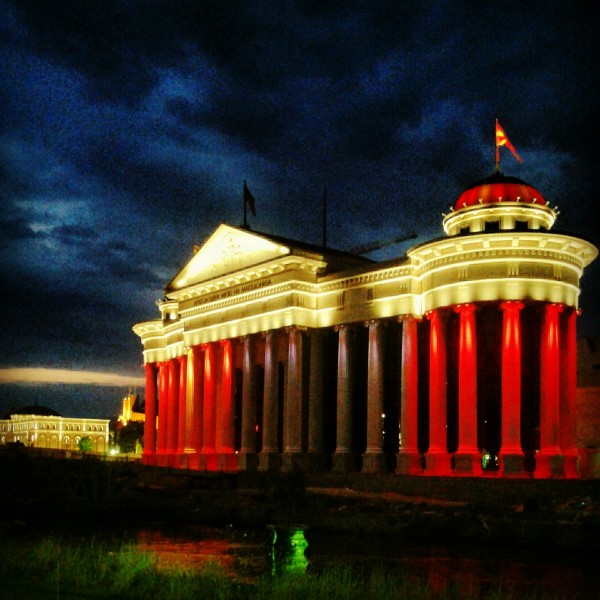
National Archaeological Museum of Skopje (FYROMacedonia)
We took the bus to Skopje early at the evening and after we passed through Kosovo we finally arrived at the Former Yugoslavian Republic of Macedonia. It was very early in the morning so everything was closed, but we were lucky to find a hostel nearby the station. The owners, a young couple who also enjoy travelling, has made a beautiful place to stay… a “home away from home” as they say! At first we were a bit biased because the last few years our countries doesn’t get along very well. They have unsolved issues regarding the name of the country, but we were happy to see that something like that doesn’t affect the local people. The gigantic statue/fountain of Alexander the Great in the center of the city, the Kale Fortress, the Memorial House of Mother Teresa and the Stone Bridge over the Vardar river are the greatest landmarks of Skopje. At night the Archaeological museum is lightened up in red and yellow, the colors of the country’s flag, creating a very beautiful reflection on the river. We spent our last night abroad at the hostel, where we met two really cool guys from the UK, Henry and Joseph. The next morning we were travelling back in Greece, first Thessaloniki and after Athens, our home. And that’s how our trip finally came to an end.
Five countries, eight cities in two weeks! It’s been the most incredible two weeks of my entire life. I visited beautiful places, met interesting people and made good new friends from all over the world. After being on the road for 15 days, I returned to Greece quite exhausted, but full with once in a lifetime experiences. I feel different, I see things different, I am different. Traveling around the Balkans I saw cultures similar to mine, but at the same time so unique. The people are polite and helpful, even though most of the time you are “lost in translation”. I feel blessed that I was given the opportunity to do something like that and will definitely do it again if I have the chance. In the end, the Balkans are an interesting and alternative way to spend your holidays.
All photos: Author

